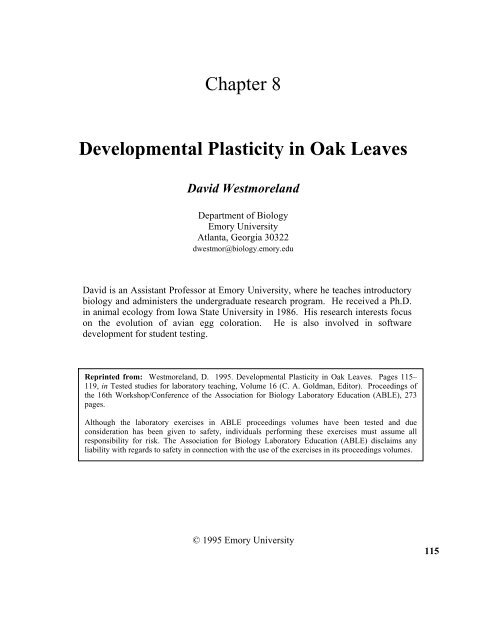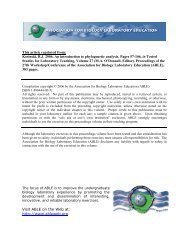Developmental Plasticity in Oak Leaves David Westmoreland
Developmental Plasticity in Oak Leaves David Westmoreland
Developmental Plasticity in Oak Leaves David Westmoreland
Create successful ePaper yourself
Turn your PDF publications into a flip-book with our unique Google optimized e-Paper software.
Chapter 8<br />
<strong>Developmental</strong> <strong>Plasticity</strong> <strong>in</strong> <strong>Oak</strong> <strong>Leaves</strong><br />
<strong>David</strong> <strong>Westmoreland</strong><br />
Department of Biology<br />
Emory University<br />
Atlanta, Georgia 30322<br />
dwestmor@biology.emory.edu<br />
<strong>David</strong> is an Assistant Professor at Emory University, where he teaches <strong>in</strong>troductory<br />
biology and adm<strong>in</strong>isters the undergraduate research program. He received a Ph.D.<br />
<strong>in</strong> animal ecology from Iowa State University <strong>in</strong> 1986. His research <strong>in</strong>terests focus<br />
on the evolution of avian egg coloration. He is also <strong>in</strong>volved <strong>in</strong> software<br />
development for student test<strong>in</strong>g.<br />
Repr<strong>in</strong>ted from: <strong>Westmoreland</strong>, D. 1995. <strong>Developmental</strong> <strong>Plasticity</strong> <strong>in</strong> <strong>Oak</strong> <strong>Leaves</strong>. Pages 115–<br />
119, <strong>in</strong> Tested studies for laboratory teach<strong>in</strong>g, Volume 16 (C. A. Goldman, Editor). Proceed<strong>in</strong>gs of<br />
the 16th Workshop/Conference of the Association for Biology Laboratory Education (ABLE), 273<br />
pages.<br />
Although the laboratory exercises <strong>in</strong> ABLE proceed<strong>in</strong>gs volumes have been tested and due<br />
consideration has been given to safety, <strong>in</strong>dividuals perform<strong>in</strong>g these exercises must assume all<br />
responsibility for risk. The Association for Biology Laboratory Education (ABLE) disclaims any<br />
liability with regards to safety <strong>in</strong> connection with the use of the exercises <strong>in</strong> its proceed<strong>in</strong>gs volumes.<br />
© 1995 Emory University<br />
115
116 Leaf Shape<br />
Contents<br />
Introduction....................................................................................................................116<br />
Materials ........................................................................................................................116<br />
Student Outl<strong>in</strong>e ..............................................................................................................116<br />
Notes for the Instructor..................................................................................................118<br />
Literature Cited..............................................................................................................118<br />
Introduction<br />
This exercise illustrates one aspect of how leaves <strong>in</strong> multilayered trees take advantage of light<br />
microenvironments. The exercise consistently yields good results and requires little equipment.<br />
The setup time is m<strong>in</strong>imal, but the procedure requires two labs that are at least 1 day apart. In the<br />
first lab, leaves are collected on a field trip. The leaves are dried overnight or longer, and data are<br />
collected from them <strong>in</strong> a subsequent lab. Work<strong>in</strong>g <strong>in</strong> groups of four, students can complete the<br />
second lab with<strong>in</strong> 3 hours.<br />
Materials<br />
For each group of four students:<br />
Plant press (1)<br />
Graph paper, 1-cm l<strong>in</strong>ed (20 sheets)<br />
A computer with statistical analysis software (t-tests or Mann-Whitney U tests)<br />
For the entire class:<br />
An electronic balance accurate to 0.1 g<br />
Student Outl<strong>in</strong>e<br />
Many species of trees are adapted so that sunlight penetrates the <strong>in</strong>terior of the canopy and<br />
shaded leaves ma<strong>in</strong>ta<strong>in</strong> a high photosynthetic rate. The relationship between light <strong>in</strong>tensity and<br />
photosynthesis is curvil<strong>in</strong>ear (Figure 8.1); thus, a leaf does not have to be <strong>in</strong> full sunlight to<br />
photosynthesize at a maximal rate. Any leaf receiv<strong>in</strong>g about 250 w/m 2 of sunlight, even if partially<br />
shaded, will photosynthesize as well as leaves that are more exposed.<br />
A tree with a large canopy should avoid excessive shad<strong>in</strong>g of the <strong>in</strong>terior leaves. In some<br />
species, this is done by vary<strong>in</strong>g leaf shape accord<strong>in</strong>g to location <strong>in</strong> the canopy. <strong>Leaves</strong> <strong>in</strong> exposed<br />
areas have larger s<strong>in</strong>uses (open spaces) that allow much of the light to penetrate to the <strong>in</strong>terior;<br />
leaves <strong>in</strong> the deeper layers are shaped to <strong>in</strong>tercept most of the light received (Figure 8.2). In<br />
addition, leaves on the canopy edge have thicker layers of photosynthesiz<strong>in</strong>g cells because <strong>in</strong>tense<br />
sunlight penetrates the leaf to a greater depth (Chabot et al., 1979).<br />
From these pr<strong>in</strong>ciples one can formulate two testable hypotheses: (1) The ratio of s<strong>in</strong>us area to<br />
leaf area should be significantly greater for exposed leaves than for leaves <strong>in</strong> the shaded <strong>in</strong>terior a<br />
canopy.<br />
(2) Specific leaf weight (g/m 2 ) should follow the same trend. Specific leaf weight is representative<br />
of leaf thickness.
Leaf Shape 117<br />
Figure 8.1. The rate of photosynthesis is affected by light <strong>in</strong>tensity up to about 250 watts/m 2 ; from<br />
that po<strong>in</strong>t on, light <strong>in</strong>tensity has no effect on photosynthesis.<br />
Figure 8.2. Change <strong>in</strong> leaf shape associated with the position <strong>in</strong> the canopy. (A) A sun leaf tends to<br />
have deeper s<strong>in</strong>uses; (B) a shade leaf has large lobes and shallow s<strong>in</strong>uses.
118 Leaf Shape<br />
Step 1: Collect the <strong>Leaves</strong><br />
Choose a tree with a full crown that can be reached from the ground. Collect 10 sun leaves<br />
from the outside edge of the canopy, and 10 shade leaves from darkest part of the <strong>in</strong>terior. Avoid<br />
leaves that have been partially eaten by <strong>in</strong>sects. Label the leaves “Sun” or “Shade”. Then, put the<br />
leaves <strong>in</strong>to a plant press to be dried overnight.<br />
Step 2: Quantify Leaf Shape and Weight<br />
To calculate leaf area, trace the leaves on centimeter-l<strong>in</strong>ed graph paper. Count the squares to<br />
calculate the leaf area. Record the data <strong>in</strong> Table 8.1. Calculate the s<strong>in</strong>us area by connect<strong>in</strong>g the leaf<br />
lobes with a straight l<strong>in</strong>e and summ<strong>in</strong>g the <strong>in</strong>scribed areas (Figure 8.2). Divide s<strong>in</strong>us area by leaf<br />
area to get the shape ratio. A high number represents a leaf with deep s<strong>in</strong>uses and narrow lobes.<br />
Weigh each leaf to 0.1 g and divide the weight by leaf area.<br />
Step 3: Data Analysis<br />
Enter the data <strong>in</strong>to a computer program, creat<strong>in</strong>g separate columns for the type of leaf, the shape<br />
ratio, and specific leaf weight (Table 8.1). Use boxplots to compare the shape ratios and specific<br />
leaf weights between sun and shade leaves. Then, follow with t-tests or Mann-Whitney U-tests to<br />
determ<strong>in</strong>e whether the differences are statistically significant.<br />
Step 4: Draw Conclusions<br />
Were the hypotheses supported, or rejected? Is there a difference between the species of trees<br />
you used, or between trees <strong>in</strong> different locations? What might expla<strong>in</strong> these differences?<br />
Notes for the Instructor<br />
The exercise follows Horn’s (1971) ideas about the adaptive geometry of trees; a useful<br />
summary is presented <strong>in</strong> Coll<strong>in</strong>veaux (1986). Suitable trees for document<strong>in</strong>g a difference <strong>in</strong> shape<br />
ratio are oaks and maples. Changes <strong>in</strong> specific leaf weight have been documented for oaks, maples,<br />
birches, aspens, and beeches (Jurik, 1986). It is a good idea to scout the field area ahead of time and<br />
select trees with full, low canopies. Warn any “testosterone-driven” tree climbers to keep their feet<br />
on the ground.<br />
Literature Cited<br />
Chabot, B. F., T. W. Jurik, and J. F. Chabot. 1979. Influence of <strong>in</strong>stantaneous and <strong>in</strong>tegrated lightflux<br />
density on leaf anatomy and photosynthesis. American Journal of Botany, 66:940–945.<br />
Coll<strong>in</strong>veaux, P. 1986. Ecology. John Wiley and Sons, New York, 725 pages.<br />
Horn, H. D. 1971. The adaptive geometry of trees. Pr<strong>in</strong>ceton University Press, 144 pages.<br />
Jurik, T. W. 1986. Temporal and spatial patterns of specific leaf weight <strong>in</strong> successional northern<br />
hardwood tree species. American Journal of Botany, 73:1083–1092.
1<br />
2<br />
3<br />
4<br />
5<br />
6<br />
7<br />
8<br />
9<br />
10<br />
11<br />
12<br />
13<br />
14<br />
15<br />
16<br />
17<br />
18<br />
19<br />
20<br />
21<br />
22<br />
Leaf Shape 119<br />
Table 8.1. One datasheet is completed by each group, then entered <strong>in</strong>to a computer program. The<br />
complete data file should <strong>in</strong>clude the data from all groups.<br />
A<br />
Leaf type<br />
Sun<br />
Sun<br />
Sun<br />
Sun<br />
Sun<br />
Sun<br />
Sun<br />
Sun<br />
Sun<br />
Sun<br />
Shade<br />
Shade<br />
Shade<br />
Shade<br />
Shade<br />
Shade<br />
Shade<br />
Shade<br />
Shade<br />
Shade<br />
B<br />
Leaf area<br />
(sq. cm)<br />
C<br />
S<strong>in</strong>us area<br />
(sq. cm)<br />
D<br />
Shape ratio<br />
E<br />
Leaf weight<br />
(g)<br />
F<br />
Weight/cm 2
















